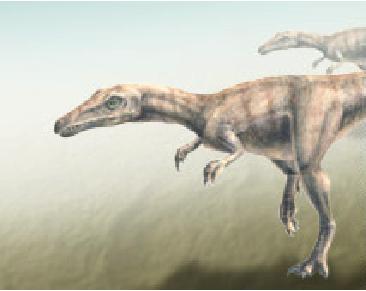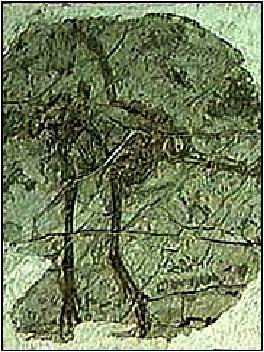The Origin of Birds - Recent Evidence Complicates Evolutionary Theories
"Scientists: Fossils prove that birds evolved from dinosaurs" was the headline of a 1998 article in CNN News (June 24, 1998). Referring to two dinosaur fossil finds, one of which is depicted below, paleontologist Philip Currie pronounced that "[t]his shows that dinosaurs are not extinct, but are well-represented by 10,000 species of birds."

Figure 1 - Artist drawing of Juravenator, a 2 1/2 feet long juvenile carnivorous dinosaur
Two recent secular publications, one by Dr. Luis Chiappe, director of the Dinosaur Institute at the Natural History Museum of Los Angeles County and Dr. Ursula B. Gohlich of the University of Munich, and another by University of North Carolina scientist Dr. Feduccia and coauthors Drs. Lingham-Soliar and Hinchliffe, suggest that, in the words of Dr. Alan Feduccia, "the origins of birds is a much more complicated question than has been previously thought." 1 ,2 Let's take a look at what these reports contain that complicate the prevailing evolutionary theory of bird origins.

Figure 2 - Researchers believe this fossil of Caudipteryx zoui represents dinosaurs that are the immediate ancestors of the first birds.
The article by Drs. Chiappe and Gohlich titled "A new carnivorous dinosaur from the Late Jurassic Solnhofen archipelago" describes the discovery of the fossil of a juvenile carnivorous dinosaur about 2 1/2 feet long that paleontologists have named Juravenator for the Jura mountains in southern Germany where it was found. According to the authors, a small patch of skin on Juravenator's tail shows no sign of feathers, and the skin doesn't have the follicles that are typical of "feathered" dinosaurs. According to Dr. Chiappe, "it has a typical scaly dinosaurian skin." To Chiappe and others who believe that birds evolved from dinosaurs this is a problem because Juravenator's closest known relative is thought to be a fully feathered dinosaur from China, Sinosauropterix. Solutions to this dilemma mentioned in the article are (1) feathers were lost on the evolutionary line leading to Juravenator after arising in an ancestor to both it and its feathered relatives or (2) feathers evolved more than once in dinosaurs, appearing in separate species at different times and places. Another possibility, not entertained by the authors, is that feathers on dinosaurs exist only in the imaginative and perhaps minds of paleontologists anxious to solve or get credit for solving another of the many evasive evolutionary mysteries. Evidence for this latter explanation was presented by Dr. Feduccia and fellow scientists in their detailed publication. 2
Dr. Feduccia and his colleagues, Drs. Theagarten Lingham-Soliar of the University of KwaZulu-Natal in South Africa and Richard Hinchliffe of the University College of Wales, suggest that no good evidence exists that fossilized structures found in China and which some paleontologists claim are the earliest known rudimentary feathers were really feathers at all. Instead, the fossilized patterns appear to these scientists to be bits of decomposed skin and supporting tissues that just happen to resemble feathers to a modest degree. They say that as a result of their new research and other studies, continuing, exaggerated controversies over feathered dinosaurs make no sense. "We all agree that birds and dinosaurs had some reptilian ancestors in common," said Feduccia, professor of biology in UNC's College of Arts and Sciences. "But to say dinosaurs were the ancestors of the modern birds we see flying around outside today because we would like them to be is a big mistake."
According to a recent UNC news release, 3 the team used high-powered microscopes to examine the skin of modern reptiles, the effects of decomposition on skin and the fossil evidence relating to alleged "protofeathers." They found that fossilized patterns that resemble feathers somewhat also occur in fossils known not to be closely related to birds and hence are far more likely to be skin-related tissues. Much of the confusion arose from the fact that in China in the same area, two sets of fossils were found. Some of these had true feathers and were indeed birds known as microraptors, while others did not and should not be considered birds at all.
"With the advent of 'feathered dinosaurs,' we are truly witnessing the beginnings of the meltdown of the field of paleontology."
Alan Feduccia, PhD
Although a few artists depicted feathered dinosaurs as far back as the 1970s, Feduccia said the strongest case for feathered dinosaurs arose in 1996 with a small black and white photo of the early Cretaceous period small dinosaur Sinosauropteryx, which sported a coat of filamentous structures some called "dino-fuzz". "The photo subsequently appeared in various prominent publications as the long-sought 'definitive' evidence of dinosaur 'feathers' and that birds were descended from dinosaurs," Feduccia said. "Yet no one ever bothered to provide evidence, either structural or biological, that these structures had anything to do with feathers. In our new work, we show that these and other filamentous structures were not protofeathers, but rather the remains of collagenous fiber meshworks that reinforced the skin." According to Feduccia, "collagen is a scleroprotein, the chief structural protein of the connective tissue layer of skin. Naturally, because of its low solubility in water and its organization as tough, inelastic fiber networks, we would expect it to be preserved occasionally from flayed skin during the fossilization process."
"The researchers also examined evidence from five independent, agreeing studies involving structural and genetic analyses related to the 'tridactyl' or three-fingered hand, which is composed of digits 1, 2, and 3 in dinosaurs," Feduccia said. That is the most critical characteristic linking birds to dinosaurs. They found that embryos of developing birds differed significantly in that bird wings arose from digits 2, 3, and 4, the equivalent of index, middle, and ring fingers of humans. To change so radically during evolution would be highly unlikely. "If birds descended from dinosaurs, we would expect the same 1, 2, and 3 pattern," Feduccia said.
"Current dinosaurian dogma requires that all the intricate adaptations of birds' wings and feathers for flight evolved in a flightless dinosaur and then somehow became useful for flight only much later," Feduccia said. That is "close to being non-Darwinian."
Also, the current feathered dinosaurs theory makes little sense time-wise either because it holds that all stages of feather evolution and bird ancestry occurred some 125 million years ago in the early Cretaceous fossils unearthed in China. "That's some 25 million years after the time of Archaeopteryx, which already was a bird in the modern sense," Feduccia said. "Superficially bird-like dinosaurs occurred some 25 million to 80 million years after the earliest known bird, which is 150 million years old." One explanation for this that has been provided by evolutionists is that, given the "improbability of fossilisation," pre-Archaeopteryx dinobirds were simply not preserved. 4
Feduccia said the publication and promotion of feathered dinosaurs by the popular press and by prestigious journals and magazines, including National Geographic, Nature, and Science, have made it difficult for opposing views to get a proper hearing. "With the advent of 'feathered dinosaurs,' we are truly witnessing the beginnings of the meltdown of the field of paleontology," he said. "Just as the discovery of a four-chambered heart in a dinosaur described in 2000 in an article in Science turned out to be an artifact, feathered dinosaurs too have become part of the fantasia of this field. Much of this is part of the delusional fantasy of the world of dinosaurs, the wishful hope that one can finally study dinosaurs at the backyard bird feeder." 3
Dr. Feduccia is the author of more than 150 papers and six major books, including The Age of Birds, which Harvard University Press published in 1980 and The Origin and Evolution of Birds , published by Yale University Press in 1996. Among other discoveries, Dr. Feduccia found that Archaeopteryx, the earliest known bird and one of the world's most famous fossils, could fly by observing that the fossil's feathers had leading edges significantly shorter than their trailing edges, which is characteristic of all modern flying birds. The edges of feather of birds incapable of flight, such as ostriches, are symmetrical. 3
Though Dr. Feduccia does not believe that dinosaurs evolved into birds, he does agree with most evolutionists that sometime in the past, fast-running, birdlike animals developed wings that enabled them to lift away from the ground and eventually fly. One simpler, less complicated creationist view is that birds were created before land reptiles on Day 5 of God's creation week (Genesis 1:20-23) and that dinosaurs were created after birds on Day 6 of the creation week (Genesis 1:24-31). To those who do not believe in a creator God (or take a liberal view of scripture), the latter is foolishness and the former is a puzzle worthy only of the educated and intelligent. Yet, God's word in 1 Corinthians (Chapter 1) reminds us of the pitfalls of becoming too comfortable in the embrace of our own human intelligence.
20 Where is the wise man? Where is the scholar? Where is the philosopher of this age? Has not God made foolish the wisdom of the world? 21For since in the wisdom of God the world through its wisdom did not know him, God was pleased through the foolishness of what was preached to save those who believe. 22Jews demand miraculous signs and Greeks look for wisdom, 23but we preach Christ crucified: a stumbling block to Jews and foolishness to Gentiles, 24but to those whom God has called, both Jews and Greeks, Christ the power of God and the wisdom of God. 25For the foolishness of God is wiser than man's wisdom, and the weakness of God is stronger than man's strength.
- 1Gohlich, U.B. and Chiappe, L.M. (2006) A new carnivorous dinosaur from the Late Jurassic Solnhofen archipelago. Nature 440:329-332
- 2 a b Feduccia, A., Lingham-Soliar, T., and Hinchliffe, J.R. (2005) Do feathered dinosaurs exist? Testing the hypothesis on neontological and paleontological evidence. J. Morphol 266:125-166
- 3 a b c Williamson, D. (2005) Latest Study: Scientists say that no evidence exists that therapod dinosaurs evolved into birds. UNC News Services 477
- 4Willis, P. (1998) Dinosaurs and Birds - The Story. The Australian Broadcasting Corporation. (www.abc.net.au/science/slab/dinobird/story.htm)